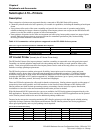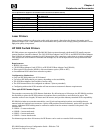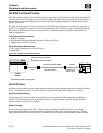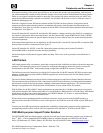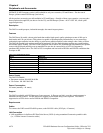
Chapter 4
Peripherals and Accessories
4-270 HP e3000 Business Servers Configuration Guide – Effective 7/03
Information Subject to Change
HP 5000 Cut Sheet Printers
HP 5000 cut sheet printers (C-Series and D-Series) are supported on HP e3000 Series 900 systems through LAN
or serial connection. LAN connection is via the HP JetDirect EX external network interface. The HP JetDirect
EX interface provides an intelligent connection between the integrated parallel port of an HP 5000 cut sheet
printer and the LAN.
HP 5000 cut sheet printers can also be connected to HP e3000 Series 900 systems by means of a serial port on
a DTC. For acceptable performance it is recommended that the DTC port have a speed of 38.4 Kbaud and that
only light text with simple electronic forms be printed. Configuration should be similar to HP LaserJet 4Si
printer configuration.
LAN Connection Requirements
• MPE/iX 5.5 or later
• HP JetDirect EX External Network Interface (J2591A or J2593A)
• Parallel Cable (C2950A or C2951A)
Serial Connection Requirements
• DTC with 38.4 Kbaud port; use Term Type 22
• Serial cable
Figure 4.10.1 HP 5000 F100 Cabling Alternatives
CIO SCSI host adapter card (27251A)
or
HP-PB SCSI host adapter card (28642A)
2 meters Option AFB: 50 meters
Option AFD: 100 meters
92222A: 0.5 meter
92222B: 1 meter
92222C: 2 meters*
F100HP e3000
900 Series
Fiber-optic SCSI extender (28643A) SCSI cable
* Recommended for extender to printer connection
Serial Printers
900 Series systems support spooled serial printers through the Data Communications and Terminal Controller
(DTC). Serial printers connect to a DTC port either via a hardwired RS-232/422 cable or via a modem.
Serial Printing Interfacing
Serial printers are considered either “local spooled” or “remote spooled” when connected to a 900 Series
system. Local spooled printers are hardwired to the DTC via either RS-232C or RS-422. Remote spooled
printers connect to the DTC via a modem.
Status Checking
If the serial printer supports the “ESC-?” status checking capability, the MPE Spooler or “hot” printing
application has the ability to determine whether a printer is on-line before spooling the print job. This will
prevent the data from being sent (and lost) to a printer that is out of paper or encountered a fault condition.



